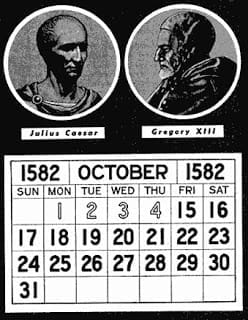愚人节和儒略历

今天是四月一日「愚人节」,还好没被整蛊(emmmm……边缘人怎么会被整呢)
从昨天开始发觉自己感冒,无精打采也无心毕设,听着几首轻音乐了解了一下「愚人节」,原来被大多数认可的来源是历法导致的。

当A使用一个历法在过新年庆祝的时候,使用另一种历法的B就嘲笑A safufu(傻乎乎)的……这一天恰巧是B所用历法的四月一日。
以下转载自 Sam Tsai
頒行格里曆的1582 年十月:消失的十天
日不落國的 1752 年九月:消失的十一天
有趣的翻译:「Julian calendar」被译作「儒略曆」!
好奇之餘,上網搜尋了一下,意外地收货了新知识:
由於「0.002%」的誤差:
儒略曆每年 365.25日 與 格里曆每年 365.2425 日。
在曆法的改革上,
每個國家、地區,因採行新曆的時間不同,
各自在月曆上「抹去」的日子,也從 10 到 13 天不等。
這樣「憑空消失」的日子,什麼時候會再來呢?
《科學發展,2015年4月,508期》
底下文字,節錄轉貼(並稍稍改寫)自維基百科:
儒略(拉丁文:Gens Iulia 或 Iulii),一譯「尤利烏斯」,是古羅馬的一个貴族氏族,現今也被用作該氏族成員「儒略・凱撒」(或:尤利烏斯・凱撒)的代名詞。這個氏族成員在羅馬共和國早期享有尊貴地位,第一位成為羅馬執政官的是公元前489年的Gaius Julius Iulus,但最為人熟知的是儒略·凱撒。
應該注意的是,大陸現在通常將此人譯作「尤利烏斯·凱撒」,但在天文學上仍沿用「儒略曆」一詞,而不是「尤利烏斯曆」。
儒略曆(Julian calendar),是格里曆(Gregorian calendar)的前身,由羅馬共和國獨裁官儒略・凱撒(Julius Caesar,後稱「凱撒大帝」)採納埃及亞歷山大的希臘數學家兼天文學家索西琴尼(Sosigenes of Alexandria)計算的曆法,在公元前45年1月1日起執行,取代舊羅馬曆曆法的一種曆法。一年設個12月,大小月交替,四年一閏,平年365日,閏年於二月底增加一閏日,年平均長度為 365.25 日。
由於累積誤差隨著時間越來越大,1582年後被教皇格里高利十三世改善,變為格里曆,即沿用至今的公曆。現今儒略曆只有阿索斯神權共和國和一些北非的柏柏爾人使用。
The Julian calendar, introduced by Julius Caesar in 46 BC (708 AUC), was a reform of the Roman calendar. It took effect in 45 BC (709 AUC), shortly after the Roman conquest of Egypt. It was the predominant calendar in the Roman world, most of Europe, and in European settlements in the Americas and elsewhere, until it was refined and gradually replaced by the Gregorian calendar, promulgated in 1582 by Pope Gregory XIII.
The Julian calendar gains against the mean tropical year at the rate of one day in 128 years. For the Gregorian the figure is one day in 3,226 years. The difference in the average length of the year between Julian (365.25 days) and Gregorian (365.2425 days) is 0.002%.
The Gregorian calendar, also called the Western calendar and the Christian calendar, is internationally the most widely used civil calendar. It is named for Pope Gregory XIII, who introduced it in 1582.
The calendar was a refinement to the Julian calendar amounting to a 0.002% correction in the length of the year. The motivation for the reform was to bring the date for the celebration of Easter to the time of the year in which it was celebrated when it was introduced by the early Church. Because the celebration of Easter was tied to the spring equinox, the Roman Catholic Church considered the steady drift in the date of Easter caused by the year being slightly too long to be undesirable. The reform was adopted initially by the Catholic countries of Europe.
現行公曆(拉丁語:Calendarium Gregorianum,又稱格里曆,又譯國瑞曆、額我略曆、格列高利曆、格里高利曆),是由義大利醫生兼哲學家阿洛伊修斯·里利烏斯(Aloysius Lilius (c. 1510 – 1576), 改革儒略曆制定的曆法,由教皇格列高利十三世(Pope Gregory XIII)在 1582 年頒行。
公曆是陽曆的一種,於1912年開始在中國正式採用,取代傳統使用的中國曆法農曆,而中國傳統曆法是一種陰陽曆,因而公曆在中文中又稱陽曆、西曆、新曆。
格里曆與儒略曆一樣,格里曆也是每四年在2月底置一閏日,但格里曆特別規定,除非能被400整除,所有的世紀年(能被100整除)都不設閏日;如此,每四百年,格里曆僅有97個閏年,比儒略曆減少 3 個閏年。
格里曆的曆年平均長度為 365.2425 日,接近平均回歸年的 365.242199074 日,即約每3300年誤差一日,也更接近春分點回歸年的 365.24237 日,即約每 8000 年誤差一日;而儒略曆的曆年為365.25 日,約每128年就誤差一日。
到 1582 年時,儒略曆的春分日(3月21日)與地球公轉到春分點的實際時間已相差10天。因此,格里曆開始實行時,將儒略曆1582年10月4日星期四的次日,為格里曆 1582年10月15日星期五,即有10天被刪除,但原星期的週期保持不變。
格里曆的紀年沿用儒略曆,自傳統的耶穌誕生年開始,稱為「公元」,亦稱「西元」。
月份名稱由來
(其實,還有好多古羅馬時的歷史細節,與拉丁文、羅馬神話等等)
一月,Januarius,名字來自古羅馬神話的神雅努斯。
二月,Februarius,名字來自古羅馬的節日 Februa。
三月,Martius,名字來自古羅馬神話的戰神瑪爾斯。
四月,Aprilis,名字來自古羅馬的詞 aperire,意思為「開始」,意味著春天開始。
五月,Maius,名字來自古羅馬神話的土地女神邁亞,或來自拉丁語詞 maiores(意為「較年長者」)。
六月,Junius,名字來自古羅馬神話的女神朱諾,或來自拉丁語詞 iuniores(意為「較年輕者」)。
七月,原名 Quintilis,後改 Julius。古羅馬曆只有10個月,這是第五月,原名是「第五」的意思,因為凱撒是這月出生的,經元老院一致通過,將此月改為凱撒的名字「儒略」。
八月,原名 Sextilis,後改 Augustus。原名是「第六」的意思,因為後來獨裁者屋大維是死於此月,元老院將此月改為他的稱號「奧古斯都」。
九月,September,拉丁語「第七」的意思。
十月,October,拉丁語「第八」的意思。
十一月,Novembris,拉丁語「第九」的意思。
十二月,December,拉丁語「第十」的意思。
